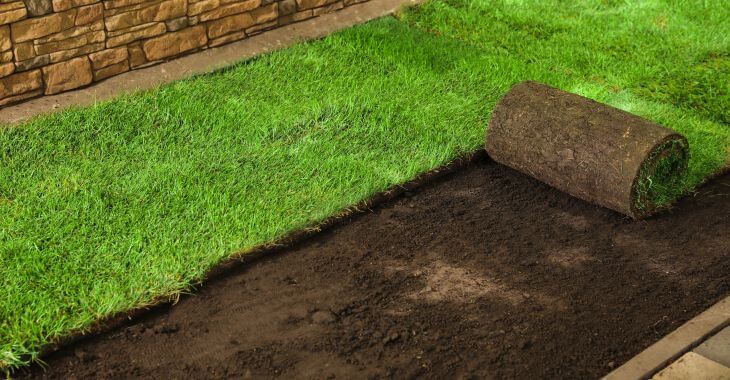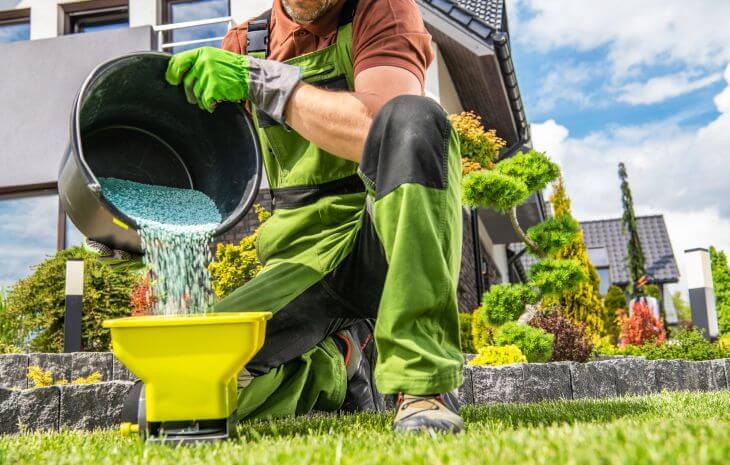Best Practices for Using Starter Fertilizer for Sod

Are you planning a new lawn using sod? With sod installation you can have a new lawn almost instantly, but it does take preparation and aftercare for the best results. One aspect of nurturing your new grass is using starter fertilizer for sod to give it the nutrients it needs to thrive.
Sod is grown at farms and specifically designed to be cut and transferred to new soil. The root system is shallow, but it can quickly grow into new soil and become healthy new turf. Preparing your soil before installation followed by watering and starter fertilizer for new sod can ensure excellent results.
Should I Use Fertilizer Before Sod Installation?
While there is preparation needed before installation of new sod, adding fertilizer is not one of the steps. You may need to till the ground and add topsoil before you level the ground. Adding some elements to the soil may be recommended but adding fertilizer before sod installation is not usually recommended.
There are different opinions regarding using fertilizer before sod is installed. It can depend on the quality of the sod and the soil where it will be installed. You do not want to add too much fertilizer, as it can burn the new grass roots; DIY sod installers should wait to add starter fertilizer until later.
Sod farms usually will use fertilizers to obtain strong and healthy grass. The sod should have enough nutrients to begin growing its roots once it is installed. While there are some nutrients that can be added to the soil before installing sod, using starter fertilizer for sod will occur after its installed.
What Is Starter Fertilizer?
Fertilizers for grass come in two basic categories: starter and maintenance. Starter fertilizers are designed to promote root growth and germination for either grass seed planting or new sod. All grass fertilizers usually contain nitrogen, phosphorus and potassium, referred to as the N-P-K ratio.
The ratio of N-P-K varies by formula, but a standard maintenance fertilizer may have equal amounts of the three nutrients. With starter fertilizers for grass, there is usually more phosphorus than the other two nutrients, which is desirable to promote root growth and germination.
Common N-P-K ratios for starter fertilizer contain at least double the phosphorus than the other two elements. You will also want a starter fertilizer that contains potassium and carbon, which help improve the hardiness of the grass and promote a better growing environment in the soil.
When to Apply Starter Fertilizer for Sod
There may be cases where fertilizer before sod is recommended, but not for all soils. If a landscaper is installing your sod, they may test your soil to check the nutrient levels. If the soil is poor, they may enhance the soil with fertilizer before installation. However, usually, starter fertilizer is added later.
The reason for waiting to fertilize your new sod is simple. The roots will take weeks to grow down into the soil and you will be watering heavily during the first several weeks. Many of the nutrients will be washed away, so it is best to wait until the roots are established before applying starter fertilizer.
Once sod is installed, it needs oxygen, water and nutrients to thrive. Water is the first element that needs to be added. Most sod will require two waterings a day for about 20 minutes each time for the first month. You want plenty of moisture, but do not overdo your watering, as it can be detrimental to sod.
After at least four weeks, you can add starter fertilizer to your sod. If you are spreading fertilizer yourself, you will want to carefully follow the instructions for your product. While there are some landscapers that will add fertilizer sooner, it can be wasteful if the roots have not been established.
How Often to Fertilize New Sod
Once your first application of starter fertilizer is applied, you will want to continue using nutrients to help your new grass grow. You want to add enough starter fertilizer for grass roots to become strongly established, but not too much to burn or damage these new roots.

In most cases, you can apply another dose of starter fertilizer for sod in about six to eight weeks after your first application. This will give it another high concentration of phosphorus and other nutrients to continue building a strong root system. After the first two applications, you will want to switch to maintenance fertilizer.
Starter fertilizer for new sod can give it the right balance of nutrients for a healthy beginning. However, soil and environment play a big role in which starter fertilizer is right for your lawn. Consult with a landscaping expert in your area to determine the best way to apply starter fertilizer to your sod.
